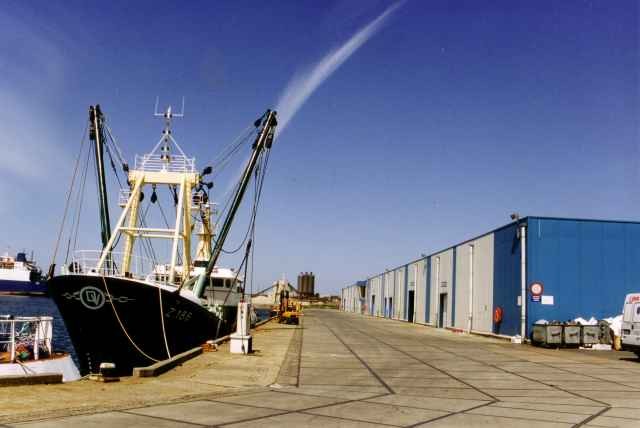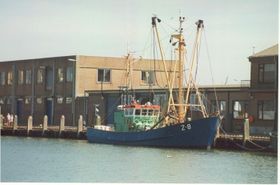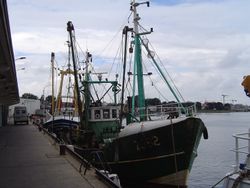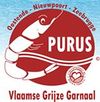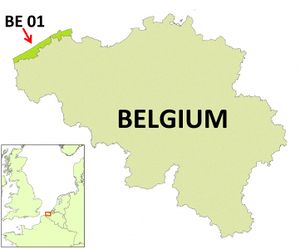Difference between revisions of "Fisheries in Zeebrugge"
(→Fish shops and restaurants) |
|||
| Line 352: | Line 352: | ||
===<span style="color:#3a75c4; Font-size: 130%">'''<small>Fish shops and restaurants</small>'''</span>=== | ===<span style="color:#3a75c4; Font-size: 130%">'''<small>Fish shops and restaurants</small>'''</span>=== | ||
---- | ---- | ||
| + | |||
| + | Several '''fish shops''' are located in Zeebrugge (click [https://maps.google.be/maps?ie=UTF-8&q=viswinkel+zeebrugge&fb=1&gl=be&hq=viswinkel&hnear=0x47c4a9960457b1c7:0xd81836ede612e886,Zeebrugge,+Bruges&ei=PGYMU6rIOYuY1AW7oYDwCg&ved=0CLwBELYD%20 here] for an overview). | ||
| + | |||
| + | The presence of the fish auction in Zeebrugge attracts '''fish processing industries'''. Some examples of fish processing industries are given below. | ||
| + | |||
| + | Fish processing company [http://www.visbewerking-neirinck.be/ Neirinck] is since 2012 located near the Flemish Fish Auction in Zeebrugge. The company is specialized in processing and fileting of fish for small fish shops but also wholesalers. The company possesses a “fileting” machine for filleting salmon. | ||
| + | |||
| + | [http://www.peterfish.be/ Peter-Fish] is a well-known wholesaler of fish located in Zeebrugge. Characteristic for the company is that they only buy and sell fish that is caught on a sustainable manner with sustainable fishing techniques such as long line fishing. Sustainability can be seen as one of the main priorities of the company. The company buys there fish in the fish auction of Zeebrugge and process them. Processing is defined as fileting and cut fish, cooking of shellfish and packing. | ||
===<span style="color:#3a75c4; Font-size: 130%">'''<small>Quality labels</small>'''</span>=== | ===<span style="color:#3a75c4; Font-size: 130%">'''<small>Quality labels</small>'''</span>=== | ||
Revision as of 12:47, 24 March 2014
Contents
Overview and Background
The Belgian coast is 67 km long and is entirely bordering the province of West-Flanders (region of Flanders, Belgium). The Belgian part of the North Sea is 3,457 km2 (0.5% of the North Sea area), of which more than 1/3 or 1,430 km² are territorial sea within 12 nautical miles distance of the coastline. Belgium currently has 10 coastal municipalities and 4 coastal ports (Nieuwpoort, Oostende, Zeebrugge and Blankenberge), and besides the fish auctions located in Oostende, Zeebrugge and Nieuwpoort where fish is sold according to legal procedures, there are no other dispersed landing points. Although historically the port and auction of Oostende was by far the most important, today the auctions of Zeebrugge (53%) and Oostende (45%) receive the largest share of the landings of Belgian fisheries in Belgian ports.
Belgium has a minor role in the European fisheries context with 0.35% of the total EU production of fish. In 2012, the Belgian commercial sea fishing fleet counted 86 ships, with a total engine capacity of 49,135 kW and gross tonnage of 15,326 GT [1]. 45 vessels are part of the Small Fleet Segment (max 221 kW engine power) of which 2 use passive gear. The remaining 41 vessels belong to the Large Fleet Segment and have an engine power between 221 kW and a maximum of 1,200 kW. This fleet segment represents approximately 80% of the engine power capacity and 77% of the GT of the fleet. While a smaller number use trammel nets (passive gear) and otter trawl, the largest share of the Large Fleet Segment are beam trawl vessels (≥662 kW). The Belgian fleet is highly specialized: more than 68% of the effort(days at sea) and 77% of total landings are achieved by beam trawlers(2010)focusing primarily on flatfish species such as plaice (Pleuronectes platessa) and sole (Solea solea). The results of the reconstruction of the Belgian fleet dynamics since 1830 are presented in Lescrauwaet et al. 2013[2].
The number of days at sea per vessel is fixed at a maximum of 265 per year and in 2011 the entire fleet realized a fishing effort of 15,855 days at sea. In 2011, the Belgian fleet landed a total of 20,138t, of which 16,905t were landed in Belgian ports. Plaice is the most important species in terms of landed weight. The landings of 2011 represented a value of €76.3 million, 14% of which was marketed in foreign ports. Sole generates 47% of the current total value of fisheries in Belgium. The Belgian sea fisheries represent 0.04% of the national Gross Domestic Product [3]. The main fishing grounds in terms of volume of landings in 2010 were in descending order: North Sea South (IVc), Eastern English Channel (VIId), North Sea Central (IVb), Southeast Ireland/Celtic Sea (VIIg) Bristol Channel (VIIf) and Irish Sea (VIIa).
In terms of direct employment, 439 fishers are registered of which approximately 350 are of Belgian nationality. Direct employment in fisheries represent approximately 0.5% of the total employment in the Belgian coastal zone. Another 1040 persons work in the fish processing industry and another 5000 persons in associated trade and services [1]. A historical overview of Belgian sea fisheries is available from [4] and [2].
The Belgian sea fishery sector is rather small compared to that of neighbouring countries in the North Sea and has been gradually losing importance since the Second World War. It is also gradually losing importance relative to the booming tourism industry in the Belgian coastal zone. However fisheries can be an added value to the tourism experience at the coast by developing fisheries-related tourism activities [5].
Port description
Zeebrugge (51°20’N 3°12’E) is a village of the Belgian coast and a subdivision of Bruges and has a population of 4000 people. Zeebrugge is Belgium’s most import fishing port and one of Europe’s largest wholesale fish market.
The port of Zeebrugge is managed by an autonomous company regulated by public law; the Port authority/MBZ nv established in 1895. In 1970’s the port of Zeebrugge developed from a coastal port into a deep sea port due to the increasing scale of the ships. A new sea lock with entrance to an inner port gave Zeebrugge new impulses. Since 1985 the total cargo traffic tripled from 14 million ton to 43.5 million ton in 2012[6].
The first fishing port of Zeebrugge was built in 1906. At that time the fishing port could harbor 40 small inshore fishing vessels. Fish was sold directly to local fish mongers. In 1909 a wooden barrack was built for fishermen to sell their fish. In 1924 the first fish auction of Zeebrugge was built on the same place as the barrack. The city council of Bruges set the first official fish sales in the fish auction in 1926. By then the fishing fleet of Zeebrugge was growing resulting in expansion of the fishing port.[7] (Anon., 1978) At the moment Zeebrugge is one of the main fishing ports in Europe. Since 2009 the fish auction of Oostende and Zeebrugge joined to form the “Flemish Fish Auction”. The "European Fish Centre" is the complex for the supply, trade and handling of fish. The Fish Auction located in Zeebrugge offers the wholesalers the possibility to join the electronic auction. The main species landed in Zeebrugge are sole, plaice, cod, lemon sole, skate, haddock, squid, scallops, shrimps, monkfish, brill, turbot and langoustines[8]. Also frozen fish is stored in the Auction of Zeebrugge, for that the Zeebrugge Food Logistics was established, a company who provides warehousing at -22°C[9].
- Fig 1: Z.186 Shannon (built in 1975) located near the new fish auction of Zeebrugge (Source: VLIZ photo gallery)
Fishing Fleet
In 2013 a total of 43 fishing vessels were registered in Zeebrugge [10] from which only 4 fishing vessel are defined as inshore fishing vessels (indicated in blue in the table below): the Z.8 AQUARIUS, Z.55 GOEDE HOOP, Z.582 ASANNAT and the Z.700 BRAVEHEART. The Belgian definition of inshore fisheries ('kustvisserij') refers to vessels with an engine power of 221 kW or less (this includes any additional installed power) and a tonnage of no more than 70 GT, that make trips with a maximum period determined by the Minister (today being 48 hours) with start and end in a Belgian port. Moreover, vessels with engine power >221 kW are not allowed to fish within the 12nm which is reserved for the inshore fisheries or Small Fleet Segment (Ministerial Decree of December 16, 2005).
| Port letters and number | Vessel name | L.O.A. in m | Tonnage | Year built | Engine power (kW) |
|---|---|---|---|---|---|
| Z.8 | AQUARIUS | 21.91 | 17 | 1967 | 220 |
| Z.18 | SOETKIN | 37.79 | 115 | 2000 | 905 |
| Z.19 | SONJA | 30.7 | 47 | 1974 | 515 |
| Z.35 | ORA ET LABORA | 38.22 | 115 | 1997 | 957 |
| Z.39 | ZUIDERZEE | 32.5 | 75 | 1982 | 706 |
| Z.45 | STEPHANIE | 37.78 | 116 | 1996 | 960 |
| Z.47 | DE MARIE LOUISE | 38.31 | 116 | 1992 | 1145 |
| Z.53 | VAN EYCK | 34.29 | 70 | 1981 | 662 |
| Z.55 | GOEDE HOOP | 23.99 | 18 | 1962 | 221 |
| Z.56 | PIETER | 23.83 | 42 | 1999 | 221 |
| Z.59 | RAQUEL | 37.2 | 82 | 1981 | 957 |
| Z.60 | BLUE ANGEL | 37.83 | 116 | 2001 | 706 |
| Z.63 | THALASSA | 20.04 | 20 | 1987 | 219 |
| Z.67 | RUBENS | 34.9 | 85 | 1984 | 707 |
| Z.75 | ZELDENRUST | 23.75 | 26 | 1986 | 218 |
| Z.80 | SILVERPIT | 23.85 | 23 | 1984 | 221 |
| Z.84 | CALYPSO | 34.9 | 85 | 1989 | 750 |
| Z.85 | MORGENSTER | 23.82 | 24 | 1987 | 221 |
| Z.90 | FRANCINE | 37.88 | 93 | 1983 | 960 |
| Z.98 | OP HOOP VAN ZEGEN | 33.67 | 81 | 1991 | 750 |
| Z.99 | ARAVIS | 29.8 | 75 | 1989 | 476 |
| Z.121 | DEBORAH | 37.87 | 115 | 1992 | 960 |
| Z.198 | MARGARET OF LADRAM | 33.07 | 79 | 1998 | 750 |
| Z.201 | JOB SENIOR | 23.94 | 41 | 1996 | 221 |
| Z.279 | RAMBLERS | 33.18 | 42 | 1969 | 221 |
| Z.296 | MOOIE MEID | 37.8 | 117 | 2000 | 957 |
| Z.333 | AVATAR | 37.45 | 115 | 1993 | 1030 |
| Z.402 | NOOITGEDACHT | 23.99 | 30 | 2000 | 221 |
| Z.431 | ALLES WISSELT | 23.94 | 39 | 1997 | 221 |
| Z.468 | CLEANER | 23.97 | 30 | 1988 | 221 |
| Z.474 | HESSEL SR. | 23.93 | 39 | 1994 | 220 |
| Z.483 | JASMINE | 37.81 | 115 | 2001 | 961.1 |
| Z.510 | DENNIS | 37.96 | 116 | 2000 | 957 |
| Z.525 | SYLVIA-MARY | 23.85 | 41 | 1997 | 221 |
| Z.526 | VAYA CON DIOS | 36.11 | 105 | 1999 | 888 |
| Z.548 | FLAMINGO | 37.72 | 118 | 1994 | 942 |
| Z.571 | CUSTOS DEUS | 38.93 | 111 | 1989 | 959 |
| Z.575 | HEIN SENIOR | 23.99 | 30 | 2000 | 221 |
| Z.576 | MARE NOSTRUM | 37.89 | 115 | 1999 | 959 |
| Z.582 | ASANNAT | 21 | 18 | 1961 | 221 |
| Z.596 | DE ZWERVER | 37.09 | 109 | 1988 | 960 |
| Z.700 | BRAVEHEART | 14.8 | 6 | 2012 | 221 |
| Z.738 | KARIENA-MARJANNE | 27.84 | 38 | 2002 | 221 |
Landings
Landings and values are available from the HiFi database from 1929 until 1999. The data from 2000-2012 that is added to the data from the HiFi database comes from the publication of Tessens and Velghe (2013)[11], the landings and values of the Belgian sea fisheries in 2012.
Fish shops and restaurants
Several fish shops are located in Zeebrugge (click here for an overview).
The presence of the fish auction in Zeebrugge attracts fish processing industries. Some examples of fish processing industries are given below.
Fish processing company Neirinck is since 2012 located near the Flemish Fish Auction in Zeebrugge. The company is specialized in processing and fileting of fish for small fish shops but also wholesalers. The company possesses a “fileting” machine for filleting salmon.
Peter-Fish is a well-known wholesaler of fish located in Zeebrugge. Characteristic for the company is that they only buy and sell fish that is caught on a sustainable manner with sustainable fishing techniques such as long line fishing. Sustainability can be seen as one of the main priorities of the company. The company buys there fish in the fish auction of Zeebrugge and process them. Processing is defined as fileting and cut fish, cooking of shellfish and packing.
Quality labels
The Flemish brown shrimp is a typical fisheries product in Belgium. In 2006 the Purus label was introduced by a cooperation of ship owners, the cooperative Flemish fisheries organization (Cooperative Vlaamse Visserij Vereniging CVBA) to promote the Flemish unpeeled brown shrimps. The brown shrimps are caught by Belgian fishermen, the fishermen fish no longer than 24 hours and the shrimps are cooked in old Flemish manner (in sea water with salt), there are no additives, preservatives added. This all results in high quality taste. The Purus label also promotes sustainable fishing techniques[12].
Since 2011, the Flemish Shellfish- and fish cooperation (VSVC) supply, via an exclusive quality label, ‘North Sea Life’, life brown shrimps and swimming crabs to restaurants and wholesalers. Life shrimps allows chefs to determine how they will prepare the shrimps. Life product forms the base of creative and gastronomic possibilities. The same is true for life swimming crabs. In 2013 a minimum of 200 kilo life brown shrimps were landed each day. Prices for life shrimps are on average 30 percent higher than shrimps cooked on board of the shrimp vessel[13].
Organisations
In Belgium, the FLAG, also called the ‘local group’, ‘Plaatselijke Groep Belgisch Zeevisserijgebied’, is a partnership between socio-economic stakeholders in the fisheries sector, NGOs and public authorities that play a crucial role in the implementation of the proposed development strategy. The lead partner of the Belgian FLAG is the Province of West Flanders. The main focus of the FLAG strategy is to add value to local fisheries products and increase local consumption. Belgian landings represent only 10% of fisheries products consumed in Belgium, leaving the remaining 90% to be met by imports. Therefore there is a considerable potential for discovering and developing local markets. It will also support diversification, innovation, the involvement of women and efforts to promote the sustainable management of the marine environment[14].
References
- ↑ 1.0 1.1 Roegiers, B.; Platteau, J.; Van Bogaert, T.; Van Gijseghem, D.; Bekaert, K.; De Bruyne, S.; Delbare, D.; Depestele, J.; Lescrauwaet, A.-K.; Moreau, K.; Polet, H.; Robbens, J.; Vandamme, S.; Van Hoey, G.; Verschueren, B. (2013). VIRA Visserijrapport 2012 Departement Landbouw en Visserij: Brussel. 98 pp.
- ↑ 2.0 2.1 Lescrauwaet, A.-K. (2013). Belgian fisheries: ten decades, seven seas, forty species: Historical time-series to reconstruct landings, catches, fleet and fishing areas from 1900. PhD Thesis. Ghent University (UGent): Gent. xiii, 242 pp.
- ↑ Anon. (2008). Strategische Milieubeoordeling van het Nationaal Operationeel Plan voor de Belgische visserijsector, 2007 - 2013. ILVO Visserij: Oostende. 103 pp.
- ↑ Lescrauwaet, A.-K.; Debergh, H.; Vincx, M.; Mees, J. (2010). Fishing in the past: Historical data on sea fisheries landings in Belgium. Mar. Policy 34(6): 1279-1289. dx.doi.org/10.1016/j.marpol.2010.05.006
- ↑ Anon. (2011). Europees Visserijfonds (EVF). AS 4: ontwikkelingsstrategie voor het Belgisch kustgebied. Europees Visserijfonds: (s.l.). 33 pp.
- ↑ Port of Zeebrugge
- ↑ Anon. (1978). Zeebrugge: vismijn, vissershaven. Gemeentebestuur Brugge: Brugge. 23, tables pp.
- ↑ Vlaamse Visveiling N.V.
- ↑ Zeebrugge Food Logistics
- ↑ Anon. (2014). Officiële lijst van de Belgische vissersvaartuigen = Liste officielle des navires de pêche belges. Toestand op 31 December 2013. Officiële lijst van de Belgische vissersvaartuigen = Liste officièlle des navires de pêche belges. Federale Overheidsdienst Mobiliteit en Vervoer: Brussel. 30 pp.
- ↑ Tessens, E.; Velghe, M. (Ed.) (2013). De Belgische zeevisserij 2012: Aanvoer en besomming: Vloot, quota, vangsten, visserijmethoden en activiteit. Dienst Zeevisserij: Oostende. 119 pp.
- ↑ De Kust kijkt verder: Purus Garnaal
- ↑ ILVO ziet in rauwe garnaal meer dan lucratieve niche
- ↑ FLAG factsheet - Belgium - West Flanders
